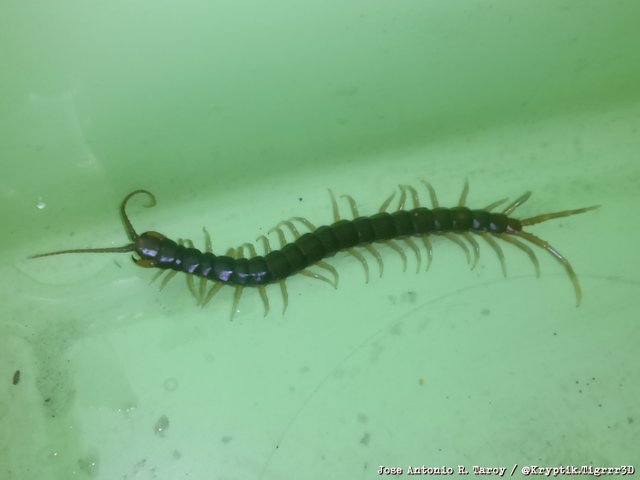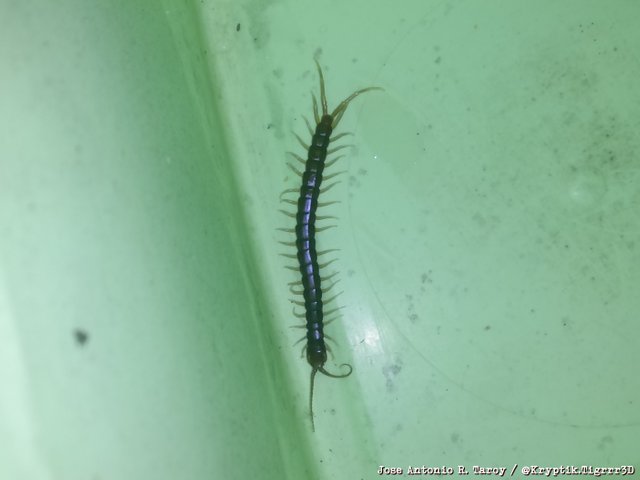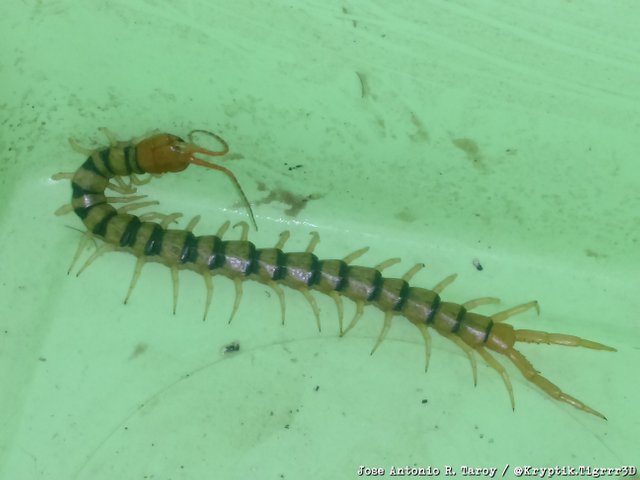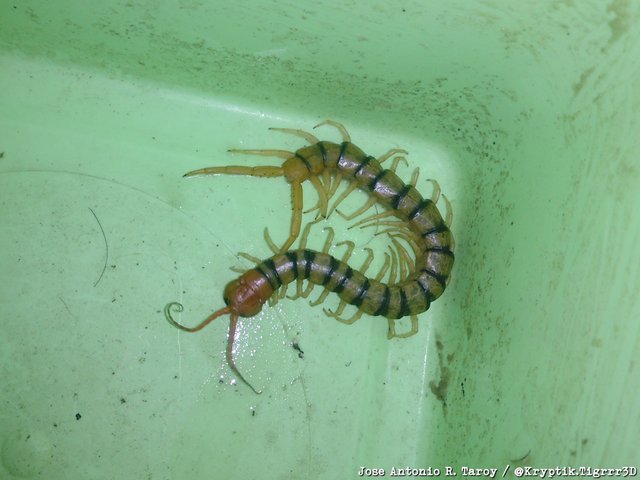Centipede!
Centipedes: The Brutal, Efficient, Carnivorous Assassins of the Bug World
Hello Steemians! I'm taking a short break from working on my next big art blog post for a fellow Steemian's portrait, to share this short post about a multi-legged venomous murder bug I caught last week. This is a creature that I have been highly fascinated with, since my first encounters with them as a young boy in the '70s.

Scolopendras, or giant centipedes, are one of the two wild and dangerous creatures that figured profoundly throughout my childhood days, while we were living right next door to the vast jungles and marshlands of Bislig, Surigao del Sur. The other one is the saltwater crocodile, which I had some encounters with in the wild. And I'll write about them someday.
I can specifically recall the first time I saw a giant centipede. It was while we were here in Manila on vacation, and I was probably about 3-years old at the time. I was playing hide-and-seek with my sister, and I ducked into one of the rooms in our house that was being used as a storeroom for unused stuff. The place I chose to hide was under my Grandpa's old desk. And while it was dark in the room, I could see that the veneer on the underside of the desk was peeling.

Then I noticed something long and black, with some appendages sticking out on either side of it. There was a clothes hanger nearby, and I grabbed it and poked it at the long, dark thing. It moved further up into the recesses of the peeling veneer, and I dashed out from under the desk in fear. I can vividly recall trying to explain what I had seen to my uncle, who couldn't understand what it was that seemed to have spooked me. My next encounter with it would be when we flew back to Surigao at the end of our Manila vacation.
Back in Surigao, my next sighting of this mysterious creature was during one night while having dinner. I was seated in my favorite spot which was in the corner of the dining room. And as I was eating, I saw this long, multi-legged creature leisurely crawling on the dining room floor on its way to somewhere in my corner. I followed it with my eyes, and saw it enter a hole near the corner of the floor. And, again, not knowing what it was called, I had some problem communicating my concern with my folks.
But, that ignorance suddenly changed, when one day my sister called me over to her side by the window where she pointed at something underneath the a small basin, which our Dad had placed there. My sister lifted the basin up a bit, and pointed at something. It was the mysterious creature which I had seen a couple of times in the past, and it seemed to be hunched over on something which it was devouring. Seeing it up close like that, I saw that it slightly resembled a shrimp. My sister had also called our Dad and told him to look at it.
And as I was about to touch the creature's back, he quickly blocked my arm and told me that it would bite me. So, I backed off. Then Dad brought a bottle of lighter fluid, and poured some on the creature. Then with his Zippo, he lit it up, and the hapless creature fell wriggling and writhing on the floor. Then it died. He picked it up by the terminal legs, those long hook-like legs at the last segment of the body, and said it's called a "centipede", and that it could give painful and venomous bites, kind of like a bug version of a venomous snake.

My next encounters with this terror bug happened in the next couple of years, while I was already in grade school. But these new encounters were with creatures I saw in the jungle, and were even longer and fatter than the ones we saw in our old house. Since I could already read encyclopedias by then, I found out that centipedes in the tropics could grow up to a foot long, or even more. As if a 7- or 8-inch specimen weren't nightmarish enough, imagine having a 10-incher or longer, crawling up your leg and biting you on your thigh, or worse, your privates!
I have yet to see a wild-caught one here in Manila that's more than 8-inches, as 8 happens to be common size for large specimens. If somebody says they have a 10 or longer, it's probably a captive-bred pet acquired from the trade. Yes, just like in other countries, there is a thriving pet/hobby trade here in Manila for these creatures, along with tarantulas and scorpions, which my brother used to have some of.
Some Facts About These Creatures
Centipedes are not insects, but are creatures known as myriapods, and along with insects, are part of a larger group of invertebrates called arthropods. The word "myriapod" means "many-legged", while "arthropod" means "joint-legged". Other members of the arthropod group are the crustaceans, spiders, and scorpions.
Centipedes are fast, predatory, carnivorous, and are one of the oldest extant venomous predators on the planet. They are thought to have evolved from other myriapods about 460 million years ago. That makes their lineage almost twice as old as that of the dinosaurs.
And although centipedes, and dinosaur descendants (the birds), are still around today, the centipedes remained looking not much so different than their ancestors. Just one look at their unchanged primitive form evokes a feeling of primordial terror that never fails to make your hairs stand on end.
Their venom is delivered by the pair of modified legs known as forcipules, attached just behind the head. Each forcipule is tipped with a thick, sharp claw which contains the venom glands, much like a pair of hypodermic needles filled with poison, which they stab into their prey with a pinching motion. Then the prey is devoured quickly, often while it is still alive.
Scientific classification
Kingdom: Animalia
Phylum: Arthropoda
Subphylum: Myriapoda
Class: Chilopoda
Order: Scolopendromorpha
Family: Scolopendridae
Genus: Scolopendra
Species: subspinipes
Binomial name:
Scolopendra subspinipes
Common names:
Chinese red-head, giant centipede, jungle centipede, orange-legged centipede, Asian Forest centipede, red-headed centipede, and Vietnamese centipede.
This centipede is common throughout East Asia, Australia, the South Pacific islands, and have also reached parts of Central and South America, and Africa. Their wide range of distribution has resulted in the development of regional subspecies or variants, each with its beautiful and distinct coloration, hence the many common names for this creature.
Here is a list of the subspecies along with the common names of the ones popular in the pet trade:
Scolopendra subspinipes subspinipes, or Orange-legged Jungle Centipede/Asian Forest Centipede
Scolopendra subspinipes de haani, or Malaysian Cherry Red Centipede
Scolopendra subspinipes japonica, or Japanese Centipede
Scolopendra subspinipes mutilans, or Chinese Red-Headed Centipede
Scolopendra subspinipes fulgurans
Scolopendra subspinipes gastroforeata
Scolopendra subspinipes piceoflava
Scolopendra subspinipes cingulatoides
This particular centipede I've caught is a Chinese Red-Headed Centipede, the Scolopendra subspinipes mutilans. It is also called the Golden-Head Centipede. Now, this variant, although described as "Chinese", is actually quite common here in Southeast Asia, and is the type that one will most likely see or even catch, here in Manila.
And unlike other scolopendra species, the Chinese-Red Head is a communal creature and does not harbor any aggression to other centipedes. This trait allows them to be farmed by the Chinese, either as a food source, or for its venom, which bears a lot of medical significance. The venom is being studied further, after it had been found to exhibit anti-cancer activity in tumor cells.
Videos and more pictures
Video 1
Here is a video of a small specimen of S. s. mutilans I caught last week. It is about 4-inches long, which is the typical size of most of the mutilans I have caught in this house. My brother claims to have seen longer specimens, but they were too quick for him to catch. The reason why we catch them, esp. if caught indoors, is to relocate them, as there are children in this house. This species has been implicated in the death of a 9-year old girl who had been bitten on the head, in the island of Samar. However, cause of death has been attributed to anaphylactic shock, and not to the toxicity of the venom.
Note: At time mark 2:27 is a sneak peek of a finished artwork that will be the subject of my first art blog for 2019. It is a portrait of a fellow Steemian.
Video 2
This second video shows it in an agitated stated, as its attempts to escape were proving futile. I made this last video in case I needed a movement reference for animation someday. I released it immediately after recording. Next time I catch another one I will put it in a small tank that my brother used to house one of his tarantulas in.
A video of a bigger centipede and some pictures
And for size comparison, here is a video of a bigger centipede I caught back in May 2017. But this is another red-headed species, known commonly in the pet trade as the Tanzanian Blue Ringleg, or Scolopendra morsitans. This specimen measured 6-inches, and I know for a fact that it is because I cut a 7-inch strip of paper and marked it with 1-inch divisions. Then I carefully dropped it in alongside it, when it was stretched out straight and motionless. Don't you just love its beautiful tigerstripe-like markings? It's another common centipede here in our part of the city. The pictures below will show you why it reminds me of a shrimp.



Congratulations! You've reached the end of this creepy blog post. I know some of you are feeling on edge right now, and anxiously checking around you with your feet raise off the floor. But, fear not if these creatures don't share your home with you, like they do with us.
That big one in the picture above was caught here in my bedroom, and on my bed! And I'm glad I haven't had any new encounters yet, here in my room. I hope I never have to experience that again. Only God knows how many times these nasty creatures have crawled on me while I was sleeping. While their stings are generally never fatal to a healthy adult, albeit being excruciatingly and debilitatingly painful, they have had a few deaths attributed to it.
So, if you ever encounter one, give it wide berth, or if you have to deal with it, make sure you never let it get on your skin or clothing. Once they get on your trouser leg they're hard to shake off. The tips of their legs have tiny hooks that allow them to attach themselves securely to their prey. And then you'll feel the burning pain. So read the articles in the links below. I saw some information in one of them on how to deal with getting stung.
And that's a wrap. Thank you, I hope you have enjoyed reading it, and have learned something useful. And if you are my follower and fellow artist, I have a big art blog post coming up, and it's for a portrait of a fellow Steemian artist. There's a sneak preview of it in one of the videos!
Stay tuned, and God Bless you all!
Further reading:
Centipede Wiki
Scolopendra subspinipes Wiki
Scolopendra subspinipes mutilans Wiki
Arthropod Wiki
Myriapoda Wiki
S. s. mutilans venom research and possible use in cancer treatment
Tourist gets stung by a scolopendra in El Nido, Palawan
Watch wildlife show host Coyote Peterson get stung by a scolopendra
eSteem Surfer and GIMP.
yeiks and venomous. Im not so good with creapy crawleys. I seen a rather long one not so long ago on my back wall, dont see them like that often so I took the kids out to show them. they are not good with creapy crawleys either lol
I had no idea they were venomous! Creepy indeed and I can see why you have vivid memories of seeing them as a small child and not being able to communicate what you had seen to anyone. Creepy creepy creepy!
Yes, even at that young age I knew that I couldn't call it a "worm", because Mom taught us that worms don't have legs. And whenever I would see one, it was already gone by the time we got the attention of an adult to check out what it was that spooked us. Good thing I did not think to get down on the floor and attempt to pick it up. Yes, creepy but beautiful, just like this Indian Tiger Centipede.
We have the much smaller and less attractive house centipedes here and thankfully, I very seldom see one in my house. I will not be convinced that they are anything but creepy/nasty!
We have a fine centipede here in the Pacific Northwest of North America.
They're quite common, and tend to be pretty cryptic, lurking under debris and seeking prey below the leaf mold of the understory. My work often involves disturbing such hidey holes, and more than once I've discovered one of them in a pant leg, under my shirt, or in my hair because of the tickling sensation of their many legged attempts to escape.
Despite the occasional over familiarity with one another, I have yet to be bitten by one, and all I want at that point is for them not to be on me anymore. They are pretty creepy - indeed the very definition of creepy! - but once they're off of me, I am fully able to control my bladder again.
Ours don't get much longer than a couple inches. If I suffered contact with one of the size ya'll have there, I'd probably have to go change my pants, whether it bit me or not!
Thanks!
You're welcome! And, I'm glad to share with you that you have a Scolopendra species that can grow up 8-inches or longer. It's the Scolopendra heros, commonly known as the Giant Desert Centipede, and it is endemic to the Southwestern States.
I am glad that it is the towering forests of the Pacific Northwest, not the desolate deserts of the Southwest, that I call home, and perhaps least because 8 inch centipedes don't crawl into my shoes when I am sleeping.
Where I grew up they're one of the first things you learn about because they sting like buggery DX (and the second thing is probably not to try to pull unripe mangoes off certain trees because if the sap gets in your eye well that stings like buggery too)
I remember seeing some gigantic ones at some place we visited on holiday, my mum couldn't stay in the same room after glancing at them as they creeped her out too much XD
You've managed to avoid the sting so far?
Unfortunately, no. I've been stung by a small one, maybe 2-3 inches (8 cm) long, on my left calf when I was in the third grade. It felt like a bee or a wasp sting. Thankfully, the American-trained nurse in our school knew what to do. I did not tell mum about it or she would have chewed my head off. XD
Thanks for using eSteem!
Your post has been voted as a part of eSteem encouragement program. Keep up the good work! Install Android, iOS Mobile app or Windows, Mac, Linux Surfer app, if you haven't already!
Learn more: https://esteem.app
Join our discord: https://discord.gg/8eHupPq
This post was shared in the Curation Collective Discord community for curators, and upvoted and resteemed by the @c-squared community account after manual review.
@c-squared runs a community witness. Please consider using one of your witness votes on us here
Congratulations! Your post has been selected as a daily Steemit truffle! It is listed on rank 25 of all contributions awarded today. You can find the TOP DAILY TRUFFLE PICKS HERE.
I upvoted your contribution because to my mind your post is at least 3 SBD worth and should receive 145 votes. It's now up to the lovely Steemit community to make this come true.
I am
TrufflePig, an Artificial Intelligence Bot that helps minnows and content curators using Machine Learning. If you are curious how I select content, you can find an explanation here!Have a nice day and sincerely yours,

TrufflePig